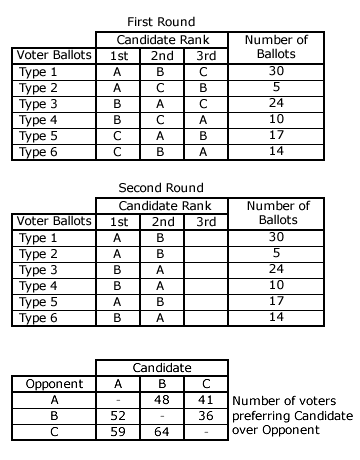Comparisons: Plurality Rule Methods 3
Resolving critical CHPV ties using Instant Run-off
Normally, all critical ties that occur in a CHPV election are resolved using random selection. However, in some circumstances, an iterative version of CHPV may be employed instead. Where there are losers as well as tied winners, the leading candidates will have a joint plurality of the tallies but not a majority of them. By re-running the contest perhaps over several rounds, with either the lowest-scoring loser or all the losers in each round being eliminated, one of the tied winners may eventually emerge with an overall majority.

The following example illustrates one such scenario where the Instant Run-off version of CHPV is successful in resolving the initial critical tie without the need for random selection. One hundred voters cast their ballots in a three-candidate CHPV election in accordance with the table shown opposite. Using the weightings of 4, 2 and 1, the resultant candidate tallies are given below. Candidate C loses while A and B tie for first place.
- TA = (35x4)+(41x2)+(24x1) = 246
- TB = (34x4)+(44x2)+(22x1) = 246
- TC = (31x4)+(15x2)+(54x1) = 208
Following the elimination of the candidate in last place or all losers (just C either way here), a second round of the election is conducted. The preference of each voter for A over B or the reverse is simply deduced from the existing ranked ballots without any need for the voters to reassess their preferences.
The next table opposite shows the votes cast in this second round. Keeping the weights for first and second place unchanged, the updated candidate tallies are given below. Candidate A not only beats B but now has a majority of the points and so emerges as the sole victor.
- TA = (52x4)+(48x2) = 304
- TB = (48x4)+(52x2) = 296
It is interesting to compare this outcome with the one produced by any Condorcet Method. The third table opposite displays the pairwise matrix for these three candidates. As most voters prefer both A over B and A over C, candidate A is the Condorcet Winner. Similarly, as they also prefer both A over C and B over C, candidate C is the Condorcet Loser. Hence, both Instant Run-off CHPV and Condorcet Methods place A first and C last in this election example.
Unfortunately, there is no guarantee that this iterative implementation of CHPV will always generate the same outcome as a Condorcet Method. In the Evaluations: General Criteria section, CHPV is assessed against Condorcet criteria. Here it is demonstrated that even where there is a Cordorcet Winner in the election, this candidate can be eliminated at the end of the very first round. Equally, it is shown that even if a Condorcet Loser exists, this candidate can win outright in the very first round. Clearly, Instant Run-off CHPV does not satify Condorcet criteria any more than standard CHPV does.
Furthermore, there are situations where a tie occurs for last place and where the leading candidates in any round are inseparable as they have the same number of preferences at each rank position. Critical ties in these and other scenarios can only be resolved by the standard procedure of random selection. Instant Run-off CHPV may sometimes be useful as a critical-tie-breaker but it is not generally recommended.
Proceed to next section > Comparisons: Summary (Single-Winner)
Return to previous page > Comparisons: Plurality Rule Methods 2
